
Orchids are plants that belong to the family Orchidaceae, a diverse and widespread group of flowering plants with blooms that are often colourful and fragrant. Orchids are cosmopolitan plants that are found in almost every habitat on Earth except glaciers. The world's richest diversity of orchid genera and species is found in the tropics.
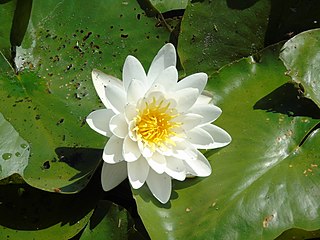
Nymphaea is a genus of hardy and tender aquatic plants in the family Nymphaeaceae. The genus has a cosmopolitan distribution. Many species are cultivated as ornamental plants, and many cultivars have been bred. Some taxa occur as introduced species where they are not native, and some are weeds. Plants of the genus are known commonly as water lilies, or waterlilies in the United Kingdom. The genus name is from the Greek νυμφαία, nymphaia and the Latin nymphaea, which mean "water lily" and were inspired by the nymphs of Greek and Latin mythology.
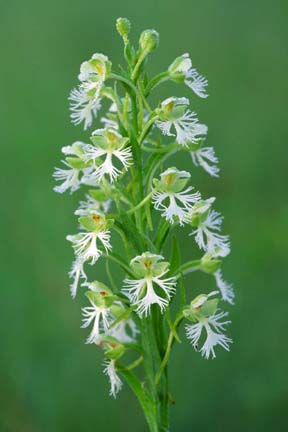
Platanthera leucophaea, commonly known as the prairie white fringed orchid or eastern prairie fringed orchid, is a rare species of orchid native to North America. It is a federally threatened species, protected since October 30, 1989 under the Endangered Species Act of 1973. In Canada, it has been listed endangered under Schedule 1 of the Species at Risk Act since 2005. In 2014, the International Union for Conservation of Nature assessed it as "least concern."
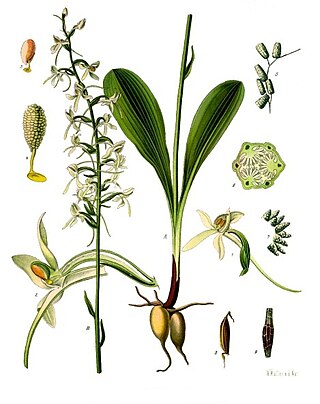
Platanthera bifolia, commonly known as the lesser butterfly-orchid, is a species of orchid in the genus Platanthera, having certain relations with the genus Orchis, where it was previously included and also with the genus Habenaria. It is a Palaearctic species occurring from Ireland in the west, across Europe and Asia to Korea and Japan. It is also found in North Africa. The name Platanthera is derived from Greek, meaning 'broad anthers', while the species name, bifolia, means 'two leaves'.

Spiranthes spiralis, commonly known as autumn lady's-tresses, is an orchid that grows in Europe and adjacent North Africa and Asia. It is a small grey-green plant. It forms a rosette of four to five pointed, sessile, ovate leaves about 3 cm (1.2 in) in length. In late summer an unbranched stem of about 10–15 cm (3.9–5.9 in) tall is produced with approximately four sheath-shaped leaves. The white flowers are about 5 mm (0.20 in) long and have a green spot on the lower lip. They are arranged in a helix around the upper half of the stalk. The species is listed in Appendix II of CITES as a species that is not currently threatened with extinction but that may become so. Autumn lady's-tresses are legally protected in Belgium and the Netherlands.

Platanthera yadonii, also known as Yadon's piperia or Yadon's rein orchid, is an endangered orchid endemic to a narrow range of coastal habitat in northern Monterey County, California. In 1998 this plant was designated as an endangered species by the United States government, the major threat to its survival being continuing land development from an expanding human population and associated habitat loss. One of the habitats of Yadon's piperia, the Del Monte Forest near Monterey, California, is the subject of a federal lawsuit, based upon endangerment of this organism along with several other endangered species.

The genus Platanthera belongs to the subfamily Orchidoideae of the family Orchidaceae, and comprises about 150 species of orchids. The members of this genus, known as the butterfly orchids or fringed orchids, were previously included in the genus Orchis, which is a close relative. They are distributed throughout the temperate regions of the Northern Hemisphere. They are terrestrial and have tubercules.

Platanthera chlorantha, commonly known as greater butterfly-orchid, is a species of orchid in the genus Platanthera. It can be found throughout Europe and Morocco. The name Platanthera is derived from Greek, meaning "broad anthers", while the species name, chlorantha, means "green-flowered".

Dactylorhiza maculata, known as the heath spotted-orchid or moorland spotted orchid, is an herbaceous perennial plant of the family Orchidaceae. It is widespread in mountainous regions across much of Europe from Portugal and Iceland east to Russia. It is also found in Algeria, Morocco, and western Siberia.

Platanthera elegans is a species of orchid known by several common names, including elegant piperia, coast piperia, hillside rein orchid, and hillside bogorchid. This is a showy flowering plant native to western North America. It grows from a caudex tuber and sends up a thick stem just under a meter in maximum height. The stem is topped with a cylindrical spike inflorescence of densely packed flowers with curving white to greenish-yellow petals. Coastal individuals are noticeably thicker and have more flowers than those that grow further inland; it is uncertain if these are variants, subspecies, or even separate species. They are both currently treated as P. elegans. Other species of Plantanthera, notably the endangered species P. yadonii are quite similar in appearance to some populations of this species.
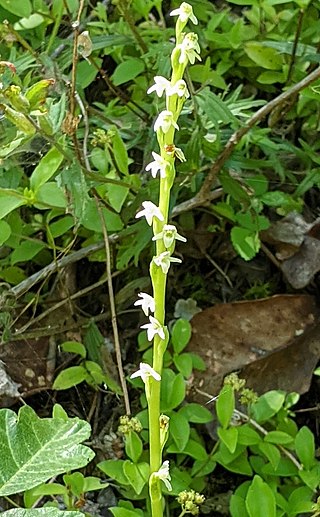
Platanthera ephemerantha is a species of orchid known by the common names whiteflower rein orchid, slender white piperia, and white-flowered piperia. It is native to western North America from Alaska to the San Francisco Bay Area, where it grows in coniferous forests and other habitat in coastal and inland mountain ranges within 150 kilometers of the coast. It grows erect to about half a meter in maximum height from a bulbous caudex. The basal leaves are up to 18 centimeters long by 3 wide. Leaves higher on the stem are much reduced. The upper part of the stem is a spikelike inflorescence of up to 100 small flowers, mostly arranged along one side of the stem. The fragrant, honey-scented flowers are whiter than those of other Platanthera, but sometimes green-tinged or -veined, or green with white margins. The status of this species in the wild is difficult to determine because most populations are small and may produce flowers only rarely.
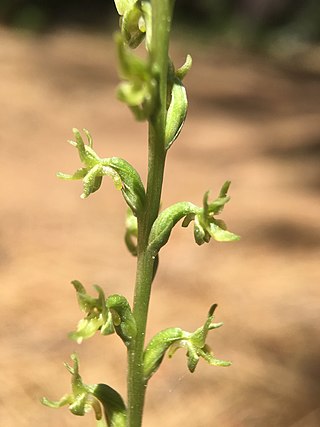
Platanthera colemanii is a rare species of orchid known by the common names Coleman's piperia and Coleman's rein orchid. It is endemic to California, where it is known from scattered occurrences along the Sierra Nevada and one disjunct location in Colusa County, California. It grows in coniferous forests and chaparral in deep sandy substrates. It was differentiated from the very similar Platanthera unalascensis in 1993.
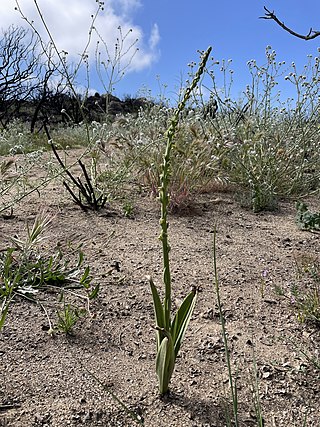
Platanthera cooperi is an uncommon species of orchid known by the common names Cooper's rein orchid and chaparral rein orchid.

Platanthera elongata is a species of orchid known by the common names denseflower rein orchid, chaparral orchid and wood rein-orchid. It is native to western North America from British Columbia and Montana to southern California, where it grows in mountain forests and scrub habitat. This orchid grows erect to about 1.3 meters in maximum height from a bulbous caudex, its stem becoming narrow toward the tip. The basal leaves are up to 30 centimeters long by 6.5 wide. Leaves higher on the stem are much reduced. The upper part of the stem is a spikelike inflorescence of many small green flowers which are sometimes densely arranged. They are sometimes faintly and variably fragrant in the evenings. The spur on each flower may be up to 1.5 centimeters long.
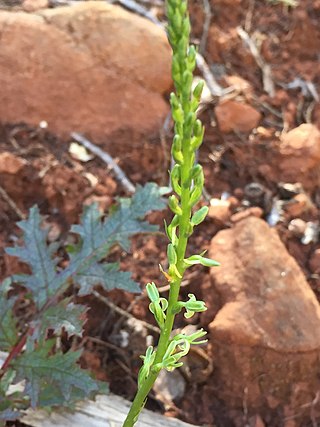
Platanthera leptopetala is a species of orchid known by the common names narrow-petal rein orchid, and lacy rein orchid. It is native to the west coast of the United States from Washington to California, where it grows in scrub and woodland habitat in mountains and foothills. This orchid grows erect to about 70 centimeters in maximum height from a bulbous caudex. The basal leaves are up to 15 centimeters long by 3 wide. Leaves higher on the stem are much reduced. The upper part of the stem is a spikelike inflorescence of many delicate, translucent green flowers which are sometimes fragrant in the evenings. This rein orchid has narrower petals than those of other species, giving the inflorescence a lacy look, as the common names suggest.

Platanthera michaelii is an uncommon species of orchid known by the common names Michael's rein orchid and Michael's piperia. It is endemic to California, where it is known from the coastal plains, hills, and mountains, and the Sierra Nevada foothills. It can be found in varied habitat, including scrub, woodland, and forest. This orchid grows erect to about 70 centimeters in maximum height from a bulbous caudex. The basal leaves are up to 24 centimeters long by 5 wide. Leaves higher on the stem are much reduced. The upper part of the stem is a spikelike inflorescence of many yellow-green flowers which are fragrant in the evenings.

Platanthera transversa is a species of orchid known by the common names royal rein orchid and flat spurred piperia.
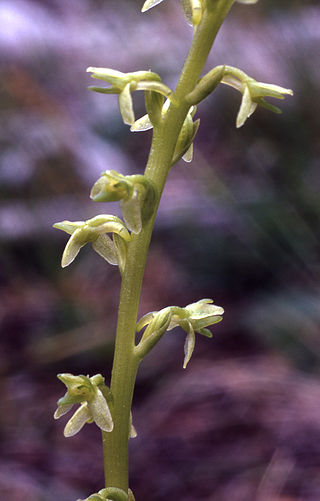
Platanthera unalascensis is a species of orchid known by the common names slender-spire orchid, Alaska piperia and Alaska rein orchid. It is native to much of western North America from Alaska to the southwestern United States, as well as eastern sections of Canada and the Great Lakes. It can be found in forest, woodland, and scrub habitat, often in dry areas. This orchid grows erect to about 70 centimeters in maximum height. The basal leaves are up to 15 centimeters long by 4 wide. Leaves higher on the stem are much reduced. The upper part of the stem is a slender, spikelike inflorescence of widely spaced translucent green flowers. The flowers are fragrant in the evenings, with a musky, soapy, or honeylike scent. The plant is variable in size, stem thickness, density of inflorescence, petal shape, and scent. Plants of the coast ranges and the Pacific Northwest are stouter and have broader sepals and petals than do interior and montane forms.

Platanthera integrilabia, commonly called white fringeless orchid, is a species of flowering plant in the orchid family (Orchidaceae). It is native to the Southeastern United States. Its natural habitat is in boggy acidic seeps and flats, usually in partial open sunlight.



















